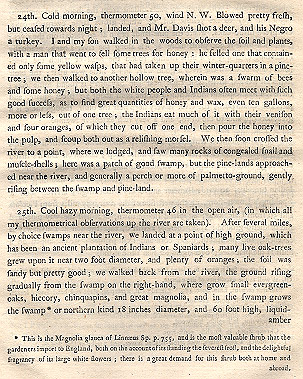

24th. Cold morning, thermometer 50, wind N.W. Blowed pretty fresh, but ceased towards night; landed, and Mr. Davis shot a deer, and his Negro a turkey. I and my son walked in the woods to observe the soil and plants, with a man that went to fell some trees for honey: he felled one that contained only some yellow wasps, that had taken up their winter-quarters in a pine-tree; we then walked to another hollow tree, wherein was a swarm of bees and some honey; but both the white people and Indians often meet with such good success, as to find great quantities of honey and wax, even ten gallons, more or less, out of one tree; the Indians eat much of it with their venison and four oranges, of which they cut off one end, then pour the honey into the pulp, and scoup both out as a relishing morsel. We then soon crossed the river to a point, where we lodged, and saw many rocks of congealed snail and muscle-shells; here was a patch of good swamp, but the pine-lands approached near the river, and generally a perch or more of palmetto-ground, gently rising between the swamp and pine-land.
25th. Cool hazy morning, thermometer 46 in the open air, (in which all my thermometrical observations up the river are taken). After several miles, by choice swamps near the river, we landed at a point of high ground, which has been an ancient plantations of Indians or Spaniards; many live oak-trees grew upon it near two foot diameter, and plenty of oranges; the soil was sandy but pretty good; we walked back from the river, the ground rising gradually from the swamp on the right-hand, where grow small evergreen-oaks, hiccory, chinaquapins, and great magnolia, and in the swamp grows the swamp* or northern kind 18 inches diameter, and 60 foot high, liquidamber and red-maple 3 foot diameter, elm, ash, and bays; the plants were most sorts of the northern ferns, saururusf, irisg, pancartiumh, large lond flowering convolvulusI running 20 foot high, chenopodiumk as high, and 4 inches diameter, pontederial and dracontium. Cloudy cool day, arrived at squire Roll's, a bluff point 17 foot high, more or less, of which 5 foot is composed of snail and muscle-shells, mixed with black mould or rotten vegetables, intermixed with sand, 20 paces distant from the shore, and diminishing all the way to the yellow soil, on which grows large evergreen-oaks, evergreen shrub-oaks, where the pine-lands begin at 50 yards from the river: This shell-bluff is 300 yards more or less along the river's bank, gradually descending each way to a little swamp, round the head of which the pine-lands continue down the river a good way, and a little up it; the bluff seems all soil and shells, but back near the Savanna's is found some clay; there is a small Spanish intrenchment on the bluff about 20 paces square, and pieces of Indian pots; the river is very deep near the bluff, though there is a great barr opposite to the town, and a very rich extensive swamp.
